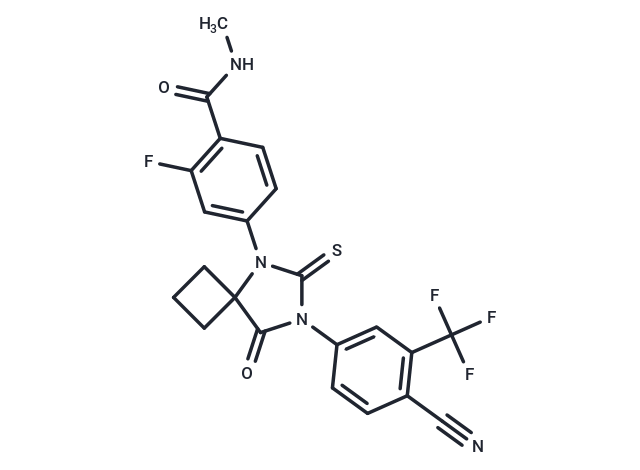Shopping Cart
- Remove All
 Your shopping cart is currently empty
Your shopping cart is currently empty

RD162 is a non-steroidal antiandrogen (NSAA) specifically binding to the androgen receptor (AR).

| Pack Size | Price | Availability | Quantity |
|---|---|---|---|
| 1 mg | $39 | In Stock | |
| 5 mg | $122 | In Stock | |
| 10 mg | $197 | In Stock | |
| 25 mg | $413 | In Stock | |
| 50 mg | $615 | In Stock | |
| 100 mg | $876 | In Stock | |
| 1 mL x 10 mM (in DMSO) | $147 | In Stock |
| Description | RD162 is a non-steroidal antiandrogen (NSAA) specifically binding to the androgen receptor (AR). |
| In vitro | RD162 has little to no binding to the progesterone, estrogen, or glucocorticoid receptors. RD162 (1-10 μM) suppressed growth and induces apoptosis in the human prostate cancer cell line VCaP which had endogenous AR gene amplification[1]. |
| In vivo | RD162 (20 mg/kg) is ∼50 percent bioavailable after oral delivery with a serum half-life of about 30 hours. RD162 (10 mg/kg; oral gavage) causes all tumors regressed. RD162 (0.1, 1, 10 mg/kg; oral gavage) consistently reduces luciferase activity with 10 mg/kg/day human LNCaP/AR xenografts grown in castrated male mice whereas lower doses of 0.1 and 1.0 mg/kg/day has minimal effect. RD162 substantially reduces cellular proliferation after 5 days[1]. |
| Molecular Weight | 476.45 |
| Formula | C22H16F4N4O2S |
| Cas No. | 915087-27-3 |
| Smiles | O=C1C2(N(C(=S)N1C3=CC(C(F)(F)F)=C(C#N)C=C3)C4=CC(F)=C(C(NC)=O)C=C4)CCC2 |
| Relative Density. | 1.55 g/cm3 |
| Storage | Powder: -20°C for 3 years | In solvent: -80°C for 1 year | Shipping with blue ice. | |||||||||||||||||||||||||||||||||||
| Solubility Information | DMSO: 50 mg/mL (104.94 mM), Sonication is recommended. | |||||||||||||||||||||||||||||||||||
Solution Preparation Table | ||||||||||||||||||||||||||||||||||||
DMSO
| ||||||||||||||||||||||||||||||||||||

Copyright © 2015-2025 TargetMol Chemicals Inc. All Rights Reserved.